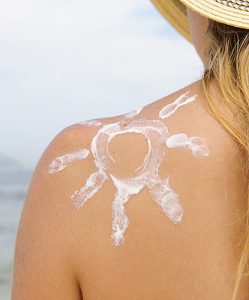SERVICES
- Allergy Screening
- Chemical Peels
- Dermapen
- Facial Skin Analysis
- FreshEyes
- Hyperhidrosis (Excessive Sweating)
- Hair Loss Treatment
- Laser Clinic
- Liquid Facelift
- Keloid Treatments
- Medical Facials
- Medical Treatments
- Mole Mapping
- Photodynamic Therapy (PDT)
- Skincare Advice
- Pigmentation Treatment
- Surgical Procedures
- Ultraviolet Phototherapy
USEFUL LINKS
 Most skin cancer can be prevented by practicing sun protection, according to numerous research studies. Research also shows that not only does sun protection reduce one’s risk of developing skin cancer; sun protection also may decrease the likelihood of recurrence.
Most skin cancer can be prevented by practicing sun protection, according to numerous research studies. Research also shows that not only does sun protection reduce one’s risk of developing skin cancer; sun protection also may decrease the likelihood of recurrence.
Even if you have spent a lot of time in the sun or developed skin cancer, it’s never too late to begin protecting your skin. Dr Jhetam recommends that everyone protect their skin by following these sun protection practices:
Sun Protection Practices
1. Avoid deliberate tanning Lying in the sun may feel good, but the end result is premature aging (wrinkles, blotchiness, and sagging skin) as well as a 1 in 5 chance of developing skin cancer. Tanning beds and sunlamps are just as dangerous because they, too, emit enough UV radiation to cause premature aging and skin cancer. If you like the look of a tan, consider using a sunless self-tanning product. These products do not protect skin from the sun, so a sunscreen should be used.
2. Get vitamin D safely through a healthy diet that includes vitamin supplements Don’t seek the sun.
3. Generously apply sunscreen to all exposed skin every day The sunscreen should have a Sun Protection Factor (SPF) of at least 30 and be broad-spectrum (provides protection from ultraviolet A (UVA) and ultraviolet B (UVB) rays). Dermatologists worldwide agree that the Australians’ use of the word “slop!” accurately describes how sunscreen should be used. Most people do not apply enough sunscreen to help protect against harmful ultraviolet (UV) radiation. One ounce, enough to fill a shot glass, is considered by the Academy to be the amount needed to cover the exposed areas of the body properly. So when applying sunscreen, remember to “slop!” it on. Here are a few more tips:
- Don’t forget your ears, nose, neck, hands, and toes. Many skin cancers develop in these areas. Protect your lips, another high-risk area, with lip balm that offers sun protection with an SPF of 30 or higher.
- Sunscreen should not be used to prolong sun exposure. Some UV light gets through sunscreen.
- Sunscreens should be applied to dry skin 15-30 minutes before going outdoors, and reapplied approximately every two hours.
- Be sure to reapply sunscreen after being in water or sweating.
- Sunscreen does not make sunbathing safe.
4. Wear protective clothing, such as a long-sleeved shirt, pants, a wide-brimmed hat, and sunglasses, where possible This is what Australians call the “slip!” and “slap!” of sun protection. When you will be out in the sun, be sure to slip on protective clothing, such as a shirt, and slap on a wide-brimmed hat. Here’s why:
- Clothing protects your skin from the sun’s harmful rays. The tighter the weave, the more sun protection provided. In fact, clothing plays such an important role in sun protection that clothing designed specifically to protect against the sun as well as laundry additives created to boost clothing’s protective function are available. Your dermatologist may be able to provide you with more information about these products.
- A wide-brimmed hat shades your face and neck from the sun’s rays. Wide-brimmed means the brim circles the entire hat and shades both the face and neck.
5. Seek shade when appropriate The sun’s rays are strongest between 10 a.m. and 4 p.m.
6. Use extra caution near water, snow, and sand as they reflect the damaging rays of the sun This can increase your risk chance of sunburn.
7. Check your birthday suit on your birthday If you notice anything changing, growing, or bleeding on your skin, see a dermatologist. Skin cancer is very treatable when caught early.
More Good Reasons…
More good reasons to Practice Sun Protection aside from skin cancer, the sun’s UV rays also cause:
- Premature aging Signs of premature aging include wrinkles, mottled skin, and loss of skin’s firmness.
- Immunosuppression (weakening of the body’s ability to protect itself from cancer and other diseases)
- Cataracts and macular degeneration Macular degeneration, for which there is no cure, is the leading cause of blindness in people aged 65 and older.
Patient Testimonials
EXCELLENTTrustindex verifies that the original source of the review is Google. From my first visit with Dr Jhetam I knew I would go back. He is compassionate , friendly and has an interaction which made you feel comfortable. This is very important in any doctor because our relationship with our doctor is very intimate.Posted onTrustindex verifies that the original source of the review is Google. Dr Jhetman is truly one of a kind. Anyone who is fortunate enough to be in his care can so grateful. Academic, informative and reassuring. It’s hard to find a doctor who has this combination of skills these days. He dealt with my Melonoma concerns with swift and professional care. And his staff are equally as competent and caring. I cannot commend Dr Jhetman and his staff enough on true patient care. Thank you!Posted onTrustindex verifies that the original source of the review is Google. I was absolutely satisfied with my experience with Dr Jhetham & his winning team. Keep up the good work.Posted onTrustindex verifies that the original source of the review is Google. Best skin doctor..Dr Jetham prescribed the best products that have brought so much of a glow to my skin..being a transplant patient and so much happening to my skin just 4 visits to him and my face is back to it's radiance ..I hightly reccomend Dr Jetham ...you won't go wrong..Posted onTrustindex verifies that the original source of the review is Google. Dr. Imraan Jhetam and his team provided exceptional care, showcasing professionalism and compassion in every interaction. Dr. Jhetam took the time to thoroughly explain everything, addressing each of my concerns with empathy and understanding. My experience with him was truly wonderful, and I highly appreciate his dedication to patient care.Verified by TrustindexTrustindex verified badge is the Universal Symbol of Trust. Only the greatest companies can get the verified badge who has a review score above 4.5, based on customer reviews over the past 12 months. Read more



